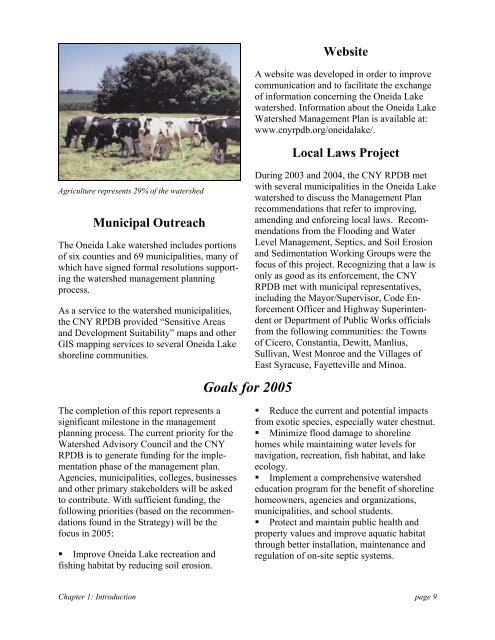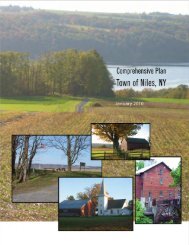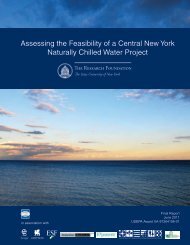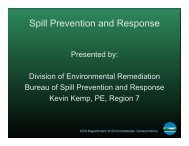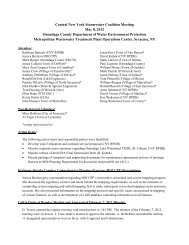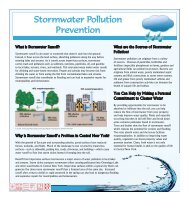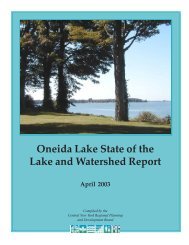A Management Strategy for Oneida Lake and its ... - CNY RPDB Home
A Management Strategy for Oneida Lake and its ... - CNY RPDB Home
A Management Strategy for Oneida Lake and its ... - CNY RPDB Home
You also want an ePaper? Increase the reach of your titles
YUMPU automatically turns print PDFs into web optimized ePapers that Google loves.
Agriculture represents 29% of the watershed<br />
Municipal Outreach<br />
The <strong>Oneida</strong> <strong>Lake</strong> watershed includes portions<br />
of six counties <strong>and</strong> 69 municipalities, many of<br />
which have signed <strong>for</strong>mal resolutions supporting<br />
the watershed management planning<br />
process.<br />
As a service to the watershed municipalities,<br />
the <strong>CNY</strong> <strong>RPDB</strong> provided “Sensitive Areas<br />
<strong>and</strong> Development Suitability” maps <strong>and</strong> other<br />
GIS mapping services to several <strong>Oneida</strong> <strong>Lake</strong><br />
shoreline communities.<br />
Goals <strong>for</strong> 2005<br />
Website<br />
A website was developed in order to improve<br />
communication <strong>and</strong> to facilitate the exchange<br />
of in<strong>for</strong>mation concerning the <strong>Oneida</strong> <strong>Lake</strong><br />
watershed. In<strong>for</strong>mation about the <strong>Oneida</strong> <strong>Lake</strong><br />
Watershed <strong>Management</strong> Plan is available at:<br />
www.cnyrpdb.org/oneidalake/.<br />
Local Laws Project<br />
During 2003 <strong>and</strong> 2004, the <strong>CNY</strong> <strong>RPDB</strong> met<br />
with several municipalities in the <strong>Oneida</strong> <strong>Lake</strong><br />
watershed to discuss the <strong>Management</strong> Plan<br />
recommendations that refer to improving,<br />
amending <strong>and</strong> en<strong>for</strong>cing local laws. Recommendations<br />
from the Flooding <strong>and</strong> Water<br />
Level <strong>Management</strong>, Septics, <strong>and</strong> Soil Erosion<br />
<strong>and</strong> Sedimentation Working Groups were the<br />
focus of this project. Recognizing that a law is<br />
only as good as <strong>its</strong> en<strong>for</strong>cement, the <strong>CNY</strong><br />
<strong>RPDB</strong> met with municipal representatives,<br />
including the Mayor/Supervisor, Code En<strong>for</strong>cement<br />
Officer <strong>and</strong> Highway Superintendent<br />
or Department of Public Works officials<br />
from the following communities: the Towns<br />
of Cicero, Constantia, Dewitt, Manlius,<br />
Sullivan, West Monroe <strong>and</strong> the Villages of<br />
East Syracuse, Fayetteville <strong>and</strong> Minoa.<br />
The completion of this report represents a<br />
significant milestone in the management<br />
planning process. The current priority <strong>for</strong> the<br />
Watershed Advisory Council <strong>and</strong> the <strong>CNY</strong><br />
<strong>RPDB</strong> is to generate funding <strong>for</strong> the implementation<br />
phase of the management plan.<br />
Agencies, municipalities, colleges, businesses<br />
<strong>and</strong> other primary stakeholders will be asked<br />
to contribute. With sufficient funding, the<br />
following priorities (based on the recommendations<br />
found in the <strong>Strategy</strong>) will be the<br />
focus in 2005:<br />
• Improve <strong>Oneida</strong> <strong>Lake</strong> recreation <strong>and</strong><br />
fishing habitat by reducing soil erosion.<br />
• Reduce the current <strong>and</strong> potential impacts<br />
from exotic species, especially water chestnut.<br />
• Minimize flood damage to shoreline<br />
homes while maintaining water levels <strong>for</strong><br />
navigation, recreation, fish habitat, <strong>and</strong> lake<br />
ecology.<br />
• Implement a comprehensive watershed<br />
education program <strong>for</strong> the benefit of shoreline<br />
homeowners, agencies <strong>and</strong> organizations,<br />
municipalities, <strong>and</strong> school students.<br />
• Protect <strong>and</strong> maintain public health <strong>and</strong><br />
property values <strong>and</strong> improve aquatic habitat<br />
through better installation, maintenance <strong>and</strong><br />
regulation of on-site septic systems.<br />
Chapter 1: Introduction page 9


